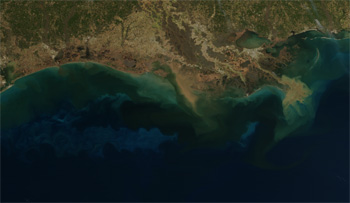Ocean Color
Team Lead: Menghua Wang
Product Description
Ocean color is the amount of light exiting the water column (excluding specular reflection at the air-water interface), specifically the outgoing radiant flux per solid angle and surface area at multiple wavelengths, e.g. normalized water-leaving radiance (nLw), and is estimated from top-of-atmosphere radiances. Geophysical quantities of interest, such as the concentration of the phytoplankton pigment (chlorophyll-a) and inherent optical properties (absorption and backscattering), of near-surface waters are derived from these nLw values or equivalent, i.e., remote sensing reflectance. VIIRS Ocean Color EDR provides continuity of observations with a selected subset of observations from heritage ocean color missions (e.g., MODIS and SeaWiFS).
Product History
MSL12 (Multi-Sensor Level-1 to Level-2) is the official VIIRS ocean color data processing system.
- MSL12 was originally developed in 1997-2003 during NASA SMIBIOS project
- Enterprise System: It has been used for producing global and regional ocean color products from various satellite ocean color sensors, e.g., the Sea-viewing Wide Field-of-view Sensor (SeaWiFS), the Modular Optoelectronic Scanner (MOS), the Ocean Color and Temperature Scanner (OCTS), the Polarization and Directionality of the Earth's Reflectance (POLDER), the Moderate Resolution Imaging Spectroradiometer (MODIS), and the Geostationary Ocean Color Imager (GOCI), etc
- MSL12 has been routinely running since the beginning of VIIRS mission and as a validation for IDPS ocean color products
- JPSS decided to use MSL12 for VIIRS ocean color data process in April 2014
- May 2014, STAR VIIRS Ocean Color team delivered MSL12 package to CoastWatch and it has been running there since then
- MSL12 will be used for all other satellite ocean color sensors, including future VIIRS on the JPSS series, e.g., JPSS-1, JPSS-2, ..., as well as sensors from international agencies, e.g., the Ocean Land Colour Instrument (OLCI) on Sentinel-3, the Second-generation Global Imager (SGLI) on GCOM-C, etc
Products and Data Access
Operational (Standard) Products:
- Normalized water-leaving radiance (nLw) at VIIRS band M1-M5
- Chlorophyll-a (Chl-a) concentration
- Diffuse attenuation coefficient for the downwelling spectral irradiance at the wavelength of 490 µm, Kd(490)
- Diffuse attenuation coefficient of the downwelling photosynthetically available radiation (PAR), Kd(PAR)
Experimental Products:
- Inherent Optical Properties (IOP-a, IOP-aph, IOP-adg, IOP-bb, IOP-bbp) at VIIRS M2 or other visible bands (M1-M5) from the Quasi-Analytical Algorithm (QAA)
- Photosynthetically Available Radiation (PAR)
- Chl-a from ocean color index (OCI) method
Users
National Marine Fisheries Service (NMFS), National Weather Service (NWS), National Ocean Service (NOS), Oceanic & Atmospheric Research (OAR), NOAA CoastWatch/OceanWatch, CoralReefWatch, NOAA Satellite and Information Service (NESDIS), European Organisation for the Exploitation of Meteorological Satellites (EUMETSAT), University of Rhode Island, University of Southern Mississippi
Data Reprocessing
- Reprocessed mission-long ocean color data and continue-forward data stream routinely
- Ocean color EDR will be reprocessed (mission-long) about every two-three years (or as needed, e.g., short-term data reprocessing, error fixing, etc.)
- Data will be processed in NOAA/STAR and transferred to CoastWatch for distributions

